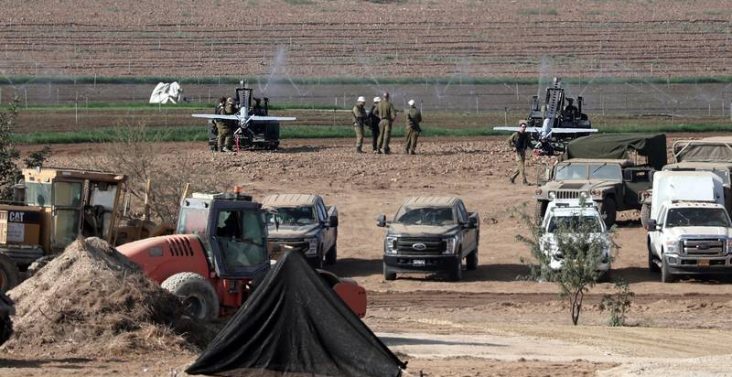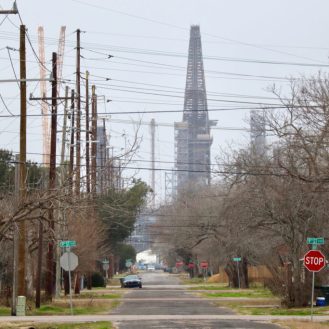Chicago Alderman Michael Rodriguez, who represents a portion of the Southwest Side’s Little Village, felt stung when developers failed to attend a meeting with residents and city officials last month to discuss the buildout of a new fleet storage yard for trucks in the neighborhood’s industrial corridor.
The 20-acre trailer yard, with more than 300 parking stalls, will serve a controversial Target warehouse nearby, and residents had questions for both no-shows, Target and Hilco Redevelopment Partners, the project developer.
When the city approved Hilco’s proposal to build the warehouse in 2018, it said the project was more environmentally sustainable than a retired coal plant that had once occupied the lot and offered an opportunity to grow employment in the low-income neighborhood. It garnered support from the Little Village Chamber of Commerce and the Illinois Hispanic Chamber of Commerce—but many local residents opposed the project, saying diesel truck storage is not a good enough alternative to the coal plant.
“You’re just switching one kind of pollution for another,” said Irma Morales, a resident from Mexico who has lived in Little Village for more than 30 years. “How is that better?”
Representatives from both Target and Hilco were invited to the meeting. Residents and Rodriguez felt the absence confirmed their worst fears about the warehouse.
“Their lack of presence is a slap in the face to all of us here, to our neighbors,” Rodriguez told the dozens of attendees at the meeting. “In the three years since the failed implosion, Hilco has done little to restore justice in the community.”
“The implosion” refers to leveling of an old coal-fired power plant and how Hilco and the city allegedly mismanaged it, ignoring a warning from the city environmental inspector that the implosion would cause harm to the neighboring residents, not giving enough notice to residents and not implementing all the measures it could to control the dust.
Hilco, Target and the city have made commitments to ease environmental and health concerns in the neighborhood, but advocates say residents still don’t have enough of a say in what gets built near their homes. With the election of a new mayor earlier this month, they hope their views will be given greater weight.
During his campaign, Mayor-elect Brandon Johnson, a progressive Cook County Commissioner, said that if elected, he’d conduct an assessment within his administration’s first 100 days to determine the cumulative impact of pollution on Chicago residents.
“My hope of Brandon Johnson is just to listen, to really listen to community members,” said Cesar Nunez, co-executive director of Enlace, a community non-profit organization focused on the improvement of the quality of life of Little Village residents.

Both Johnson’s and his opponent’s views on environmental justice were generally aligned. Each promised to bring back the Department of Environment, which was dissolved in 2012, and to support the passage of the cumulative impacts rule, which would require agencies to assess the potential impacts of proposed projects in conjunction with other projects or activities already in place.
Johnson’s background sold some residents like Morales. She said his experience as a union organizer and a Chicago Public Schools teacher makes him “of the people” and more likely to stand against corporate influence. Johnson’s biggest vote margins came in the West and South Side.
“But mentioning it and doing it are two different things,” said Kim Wasserman, an environmental justice advocate in Little Village. “It’s hard to trust that they’re actually going through with it, even if you’re hearing all the right things, you can only hope for the best. Optimism is a huge part of the job.”

A Botched Implosion Stirs Dust and Mistrust
Once seen as a driver of the city’s thriving industrial economy, Little Village’s coal-fired Crawford Power Generating Station later became a symbol of health and environmental hazards, and residents fought for more than a decade to successfully close the facility in 2012.
Hilco bought the property in 2018 with the intention of building a warehouse on the lot, despite public opposition. Two years later, an implosion felled the 378-foot-tall smokestack to make way for the warehouse, spewing out a thick cloud of dust that enveloped nearby blocks at the height of the Covid-19 pandemic.

It was Holy Saturday—April 11, 2020. “They were outside gardening, getting ready for [Easter],” Wasserman, who leads the Little Village Environmental Justice Organization, or LVEJO, said of her neighbors. “It’s a highly Catholic neighborhood.”
“They couldn’t see. They couldn’t breathe,” recalled Wasserman.
In February, an inspector general’s report obtained by the Chicago Sun-Times found that the city’s “negligence and incompetence” allowed for the dust cloud that enveloped the neighborhood. The report stated that several city departments and senior officials knew about the “cataclysmic” impact of the implosion but still decided not to stop it.
No deaths or illnesses have been officially linked to the event, but some residents complained of breathing issues. Studies of the neighborhood’s air quality and dust samples found that there is no apparent health risk to the surrounding community, according to a statement from the mayor’s office.
Three companies involved in the leveling of the smokestack settled a lawsuit with Illinois Attorney General Kwame Raoul for $370,000, and the city slapped Hilco with citations that racked up $68,000 in fines, according to the Chicago Department of Public Health.
Former inspector general Joe Ferguson, who authored the report, and Little Village residents have called on the city to officially release a report about the implosion that Mayor Lori Lightfoot has kept under wraps for a year and a half.
Since the implosion, the city enacted new zoning and demolition rules, but some residents are frustrated with the city’s oversight of development in the industrial corridor, saying they still don’t have a voice in these decisions and continue to bear a heavy burden of the city’s environmental discrimination.
Chicago’s zoning ordinance requires few opportunities for public feedback on developments proposed in their neighborhoods. Those opportunities are even more limited in industrial corridors, according to a 2020 analysis of Chicago’s zoning law. It also does not set forth criteria for examining and reviewing the environmental justice implications of those proposals.
Today, the Target warehouse is one of a dozen facilities in Little Village with diesel trucks lumbering in and out each day.
Still, the warehouse itself is the largest industrial facility in the city with LEED certification, with vast green space, bioswales, solar arrays and electric vehicle infrastructure readiness. Hilco said the warehouse has created more than 2,000 new jobs paying a minimum of nearly $20 an hour, and shortened the commute time for many Little Village residents.
“HRP is proud to have partnered with leading community and labor organizations representing thousands of families, small businesses, and workers to build a sustainable, innovative facility that is now serving as an economic engine for the neighborhood,” said Amelia Chasse Alcivar, Hilco’s executive vice president of corporate affairs.
However, as Hilco builds out its new fleet storage yard near that warehouse, some residents have lingering health concerns, struggle to trust the city’s handling of new developments in their neighborhood and argue that residents have more to offer than working at distribution centers.
‘Let Them Grow Food’
The community, also known to locals as “La Villita,” has evolved as a result of historical displacement and industrial development. It was once home to a large German and Czech, then Polish, populations. Now, Little Village’s population is more than 80 percent Hispanic. The neighborhood is home to Cook County Jail and Chicago’s second highest-grossing shopping district, a two-mile stretch known as Calle Mexico and the heart of the community.
Little Village’s industrial corridor is one of 26 designated areas across the city that are largely zoned and developed for industrial use and play a significant role in the city’s economy. The designations began in the 1980s as a way to encourage economic development and job creation in targeted locations. The city offers tax incentives and expedited permitting to attract businesses to these areas.
The corridors are home to two-thirds of the city’s manufacturing and industrial businesses and are made up of factories, distribution centers, transportation companies and more. They are located near hubs like highways, rail lines and airports to support the movement of goods in and out of the area.
Over time, they have been associated with environmental and health concerns for nearby residents as research has shown that lower-income and minority populations are more likely to live near major roads and industrial facilities, facing elevated health risks from exposure to pollutants.
About 29 percent of Little Village residents live below the poverty line, compared to about 18 percent of the city as a whole. The predominantly Hispanic community also has the highest rate of uninsured residents in the city and has high levels of food insecurity.
Like much of the city of Chicago, the community faces a higher lifetime cancer risk and respiratory issues from inhalation of air toxins than the rest of the country, according to the U.S. Environmental Protection Agency’s environmental justice mapping tool. The vast majority of Little Village is above the 95th percentile of the EPA’s environmental justice index for pollution from particulate matter, ozone, diesel particulate matter, proximity to hazardous waste and lead paint risks. It also shows that residents in Little Village are especially vulnerable to these risks due to cumulative environmental exposures and poor socioeconomic conditions.
Keep Environmental Journalism Alive
ICN provides award-winning climate coverage free of charge and advertising. We rely on donations from readers like you to keep going.
In 2018, the city began studying how to modernize the Little Village industrial corridor. Among the goals that residents and stakeholders wanted to see in the final version of the framework was the collection of more health and transportation data to inform future decisions. They also wanted the assurance that no more transportation, distribution or logistics businesses be added to the corridor.
The community advocated for a green space with multiple-use opportunities to replace the Crawford coal plant in Little Village, which also suffers from high levels of food insecurity. Then, Hilco bought the property. The company said the deed established at the closing of the property contains a restrictive covenant prohibiting Hilco or any future owner from developing or using the site for non-industrial purposes
“You’re telling me that the only way to solve [these issues] is to build a Target warehouse?” said Wasserman. “Let them build solar, let them grow food, and then help build an economy here around food.”
Expecting the Worst
After the implosion, the city enacted new rules on implosion management and demolition coordination for contractors, requiring a contingency plan if dust is not adequately controlled, submission and approval of detailed dust mitigation plans and near-real-time air monitoring for particulate matter.
In 2021, it also enacted new zoning rules requiring developers to conduct a traffic study and air impact evaluation, allowing the Chicago Department of Transportation and Department of Public Health to make recommendations at the time of zoning.
After years of environmental advocacy in the community, Morales said it’s sometimes hard to stay optimistic. “The city will build what they want to build,” she said. “But sometimes I get a nagging feeling saying, ‘You need to do something about this.’”
Advocates are demanding that the city conduct more soil sampling in homes near where the implosion occurred and that Hilco pay for the tests. Rodriguez, who some residents have been critical of for not doing enough to stop the implosion, said he is calling on Target to commit to more electric fleets. They are also pushing the city to enact the cumulative impacts rule.

Target is working toward becoming a net zero enterprise by 2040, the company said in an email to Inside Climate News. “Specific to trucking, in most cases, we hire other companies to deliver our products to our stores, and we’re working closely with them to implement emissions-reduction programs in their own organizations.”
Hilco sent air quality studies on the proposed fleet storage yard to the Chicago Department of Public Health. They showed that the fleet storage facility would not exceed national quality standards and would be lower than they were in prior conditions, the department told Inside Climate News. The department also said it sent recommendations to the company, including that Hilco conducts ongoing air monitoring for both the warehouse and the yard, which the company agreed to.
Hilco also committed to a plan to prevent the idling of trucks, employing dust control measures and planting more than 400 trees.
But some remain wary of development plans, including Hilco’s proposed fleet storage yard, said Wasserman.
“Unfortunately, we’ve learned to expect the worst,” she said. “These systems aren’t meant to protect us. They’re meant to sacrifice us.”









